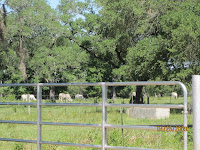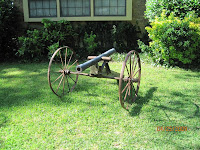.JPG)
.JPG)
.JPG)
.JPG)
.JPG)
.JPG)
.JPG)


.JPG)
.JPG)

.JPG)
.JPG)
.JPG)

.JPG)
.JPG)
.JPG)
.JPG)


.JPG)


.JPG)

.JPG)

.JPG)

.JPG)
.JPG)
.JPG)
.JPG)
.JPG)

.JPG)
.JPG)
.JPG)
.JPG)
.JPG)
.JPG)
.JPG)
.JPG)






This morning we really weren't in to much of a hurry as we only had a few caches left to do in Columbus so we kind of took our time leaving. First cache was located at someone's house in Columbus and it was hidden in the barrel of the old cannon sitting on the front lawn that you see in one of the pictures.
Our second cache was at the Beason's Park on the Colorado part of the Colorado River Trail. It was behind an old foundation and was the real turtle shell you can see in one of the pictures. There was some history at the park as it was the site of Beason's Crossing. Benjamin Beason, one of Stephen F. Austin's original 300 colonists, settled by a widely used Colorado River crossing near here in 1822. He and his wife Elizabeth proceeded to build a large home (also used as an inn) and established a gristmill, sawmill, gin,and ferry operation at the crossing. His residence and business operations and a scattering of homesteads in the area formed a settlement known as Beason's Crossing. In the early spring of 1836 Beason found his home, family, and complex of commercial buildings in the perilous position in between Sam Houston's Army, camped on the east bank of the Colorado River opposite Beason's crossing, and a Mexican Army led by General Juaquin Ramirez Y Sesma fast approaching from the west. Houston had chosen this site to camp because of its strategic location at the edge of the most populous part of Texas. With his 1500 troops in position, Houston is said to have declared, "on the Colorado I make my stand." Notwithstanding this bold declaration, Houston unexpectedly removed his Army to the Brazos River on March 26th. Beason's crossing was subsequently burned to the ground by a detachment of Houston's Army scarcely hours before the arrival of Sesma's Army. There also is a 6.5 mile canoe or kayak trail which can take anywhere from two to five hours to complete, and the peaceful waters and calm rapids will give you a wonderful day on the river. On this stretch of the Colorado River you will see a mix of gently sloping to steep sandy banks, flat flood plains, and tree-lined ridges with mature trees. Enjoy this wide, open, peaceful trail with a few calm rapids and multiple islands great for picnicing during first third of the trail. You will pass several cattle ranches and very few houses as you paddle. Look forward to a spectacular wildflower display during the spring. Bring your binoculars and field guide to enjoy birding. You could spot vultures, cardinals, egrets, flycatchers, herons, hawks, Ibis, killdeer, and even Roseate Spoonbills. Among the many trees, look for Bald Cypress, Box Elder, Buckeye, Cottonwood, Sycamore and Willow. You will also see an interesting mix of flowering Hibiscus and Button-Bush, Arizona Trumpet and Kudzu Vines, and a variety of Cactus. If it’s sunny, you might see turtles basking on a log or a water snake.
Next cache was located on the banks of the Colorado River where some Texas history was made. This is the camp site of the Mexican General Santa Anna on the night of March 24 (19-25), 1836. On the oppisite bank of the Colorado River was the rag tag army of the new Repbulic of Texas led by Sam Houston in retreat. Houston had said, "On the Colorado River, I will make my stand." But no, he was going to San Jacinto, where he and this battered army would give the great State of Texas its new republic of freedom on April 21, 1836. History was to be made.
Also on one of the other banks some more history was made back in the late 1800's. Robert Robson (1804-1878), one of many Scotsmen seeking fortune in North America, came to the Texas Republic in 1839. On land he owned at this site, he built a concrete "castle," using native lime and gravel. It had running water, pumped from the Colorado into a tank on the roof, then through wooden pipes to its many rooms. It also had a roof garden and an encircling moat, with drawbridge. From Bastrop to Matagorda, it drew guests to Champagne suppers, card parties, and balls. Undermined by an 1869 flood, it became a ruin and was razed when site was put to new use in 1880s. Columbus, Texas, Meat & Ice Company built its 3-story plant on this site in 1884. It was then one of three packing houses in Texas. Established to process at place of origin, the plant could handle 125 cattle a day. Some of its beef went to Queen Victoria's London. Robert E. Stafford (1834-1890), a wealthy trail driver and rancher, veteran of Civil War service with famous Hood's Texas Brigade, owner of a private bank and extensive Colorado County properties, was president, and major stockholder in the packing house. In the early 1890s, after Stafford died, the plant closed.
Next cache was at Gay Hill Cemetery a small cemetery way out in the country and on our was to it we passed the Brahma Bull Ranch you see in the pictures. Next 2 caches were out on country roads one at the entrance to a campground and the other hanging on a tree in the middle of nowhere. Then we drove back into Columbus and drove around looking at the Opera House, Courthouse, the old buildings along the main street, the old homes and bed & breakfasts. We even ran into a drive through BBQ and bake sale on the main street and we bought a caramel-pecan coffee cake that was homemade by someone in Columbus. Then it was back to the coach for the afternoon and evening. Well that's about all for today so until tomorrow we love and miss you all. Mom & Dad Dori & Dick

No comments:
Post a Comment